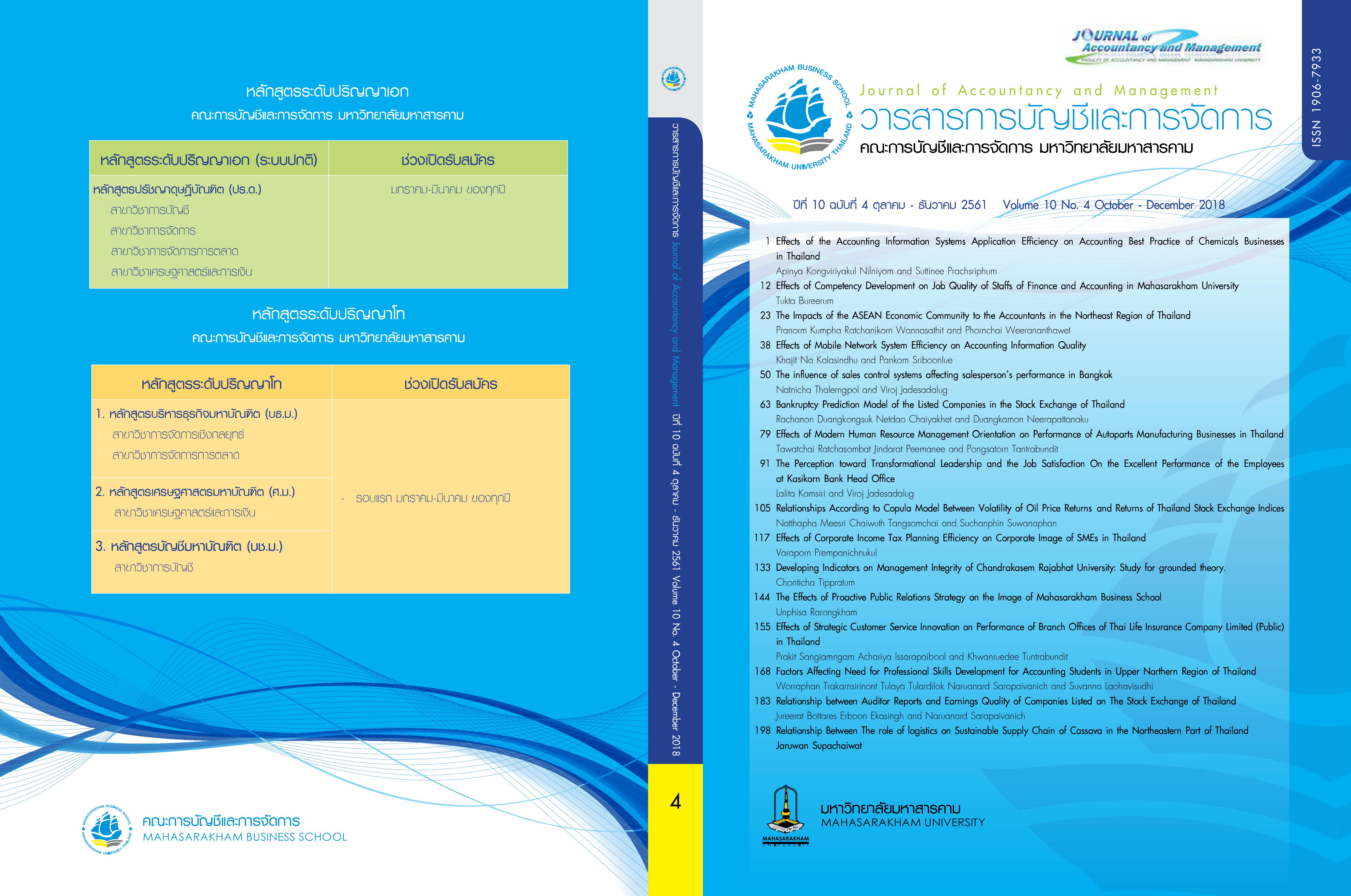ผลกระทบของนวัตกรรมการบริการลูกค้าเชิงกลยุทธ์ที่มีต่อผลการดำเนินงาน ของสำนักงานสาขา บริษัท ไทยประกันชีวิต จำกัด (มหาชน) ในประเทศไทย
Main Article Content
บทคัดย่อ
การศึกษาวิจัยนี้ มีวัตถุประสงค์เพื่อศึกษาผลกระทบของนวัตกรรมการบริการลูกค้าเชิงกลยุทธ์ ที่มีผลต่อ การดำเนินงานของสำนักงานสาขา บริษัท ไทยประกันชีวิต จำกัด (มหาชน) ในประเทศไทย โดยใช้แบบสอบถามเป็นเครื่องมือในการเก็บรวบรวมข้อมูล โดยทำการเก็บรวบรวมข้อมูลจากผู้บริหารสำนักงานสาขา บริษัท ไทยประกันชีวิต จำกัด (มหาชน) ในประเทศไทย จำนวน 308 คน สถิติที่ใช้ในการวิเคราะห์ข้อมูล ได้แก่ ค่าเฉลี่ย ส่วนเบี่ยงเบนมาตรฐาน การวิเคราะห์สหสัมพันธ์พหุคูณและการวิเคราะห์การถดถอยแบบพหุคูณ ซึ่งนวัตกรรมการบริการลูกค้าเชิงกลยุทธ์ได้ถูกกำหนดให้เป็นตัวแปรอิสระที่มีผลกระทบต่อผลการดำเนินงาน ผลการวิจัย พบว่า นวัตกรรมการบริการลูกค้าเชิงกลยุทธ์ด้านการสร้างคุณค่าเพื่อลูกค้า มีความสัมพันธ์และผลกระทบเชิงบวกกับผลการดำเนินงานโดยรวม ดังนั้นสำนักงานสาขา ควรให้ความสำคัญกับนวัตกรรมการบริการลูกค้าเชิงกลยุทธ์ ในการวางแผน ปรับปรุง และพัฒนาประสิทธิภาพของการดำเนินงาน ยิ่งไปกว่านั้นความสนใจในรูปแบบที่หลากหลายของนวัตกรรมการบริการลูกค้า ยังมีความสำคัญต่อการพัฒนาธุรกิจและนำไปสู่ความสำเร็จขององค์การที่ยั่งยืนต่อไป
Downloads
Article Details
บทความที่ได้รับการตีพิมพ์เป็นลิขสิทธิ์ของวารสารการบัญชีและการจัดการ
ข้อความที่ปรากฏในบทความแต่ละเรื่องในวารสารวิชาการเล่มนี้เป็นความคิดเห็นส่วนตัวของผู้เขียนแต่ละท่านไม่เกี่ยวข้องกับมหาวิทยาลัยมหาสารคาม และคณาจารย์ท่านอื่นๆในมหาวิทยาลัยฯ แต่อย่างใด ความรับผิดชอบองค์ประกอบทั้งหมดของบทความแต่ละเรื่องเป็นของผู้เขียนแต่ละท่าน หากมีความผิดพลาดใดๆ ผู้เขียนแต่ละท่านจะรับผิดชอบบทความของตนเองแต่ผู้เดียว
เอกสารอ้างอิง
วิทยานิพนธ์ บธ.ม. มหาสารคาม : มหาวิทยาลัยมหาสารคาม.
ขจิตพันธุ์ เปรื่องปราชญ์. (2549). การประกันชีวิต สาระความรู้สำหรับนักอุตสาหกรรม. กรุงเทพฯ :
กรมวิชาการ กระทรวงศึกษาธิการ.
ดนัย เทียนพุฒิ. (2546). ดัชนีวัดผลสำเร็จธุรกิจ (KPIs) และการประเมินองค์กรแบบสมดุล (BSC). กรุงเทพฯ :
ดี เอ็น ที คอนซัลแตนท์.
ดนัย เทียนพุฒิ. (2551). นวัตกรรมการบริการลูกค้า (พิมพ์ครั้งที่ 2). กรุงเทพฯ : ส.บุ๊คแบงก์
นิตยสารรายสัปดาห์. (2552). บทความและสาระความรู้. ค้นเมื่อ 21 มีนาคม 2559,
จาก https://www.tlaa.org/www/th/history/index.php
นฤดี จิยะวรนันท์. (2553). การออกแบบนวัตกรรมด้านการบริการ. การศึกษาค้นคว้าอิสระ. บธ.ม. กรุงเทพฯ :
มหาวิทยาลัยเกษตรศาสตร์.
นันทนา อุ่นเจริญ. (2549). การสร้างศักยภาพในการแข่งขันของธุรกิจโรงแรมในประเทศไทย : ผลกระทบของ
ประสิทธิผลการสื่อสารการตลาดแบบบูรณาการ. วิทยานิพนธ์ บธ.ม. ขอนแก่น : มหาวิทยาลัยขอนแก่น.
บุญชม ศรีสะอาด. (2545). วิธีการสร้างสถิติสำหรับการวิจัย (พิมพ์ครั้งที่ 7). กรุงเทพฯ : สุวีริยาสาส์น.
บริษัท ไทยประกันชีวิต จำกัด (มหาชน). (2558). 26 ปี กรมการประกันภัย. กรุงเทพฯ : กรรมการประกันภัย กระทรวงพาณิชย์.
บริษัท ไทยประกันชีวิต จำกัด (มหาชน). (2556). ค้นเมื่อ 23 พฤศจิกายน 2559, จาก https://www.thailife.com/iservice/
พสุ เดชะรินทร์. (2547). เส้นทางจากกลยุทธ์สู่การปฏิบัติด้วย Balanced scorecard และ Key performance Indicator.
กรุงเทพฯ : ผู้จัดการ.
พสุ เดชะรินทร์. (2548). กลยุทธ์ใหม่ในการจัดการ. กรุงเทพฯ : ผู้จัดการ.
เรวัตร์ ชาตรีวิศิษฐ์. (2553). การจัดการเชิงกลยุทธ์. (พิมพ์ครั้งที่ 2). กรุงเทพฯ : ถังทรัพย์การพิมพ์.
สมบัติ ท้ายเรือ. (2552). ระเบียบวิธีวิจัยสำหรับมนุษยศาสตร์และสังคมศาสตร์. พิมพ์ครั้งที่ 3. มหาสารคาม :
สำนักพิมพ์มหาวิทยาลัยมหาสารคาม.
อนุชา ติณรัตน์. (2555). ผลกระทบการบริหารทีมขายเชิงกลยุทธ์ที่มีต่อผลการดำเนินงานของหัวหน้าทีมขายตัวแทน
ประกันชีวิต บริษัท อเมริกันอินเตอร์แนชชั่นแนล แอสชัวรันส์ จำกัด ในเขตภาคตะวันออกเฉียงเหนือ.
วิทยานิพนธ์ บธ.ม. มหาสารคาม : มหาวิทยาลัยมหาสารคาม
Aaker, D. A., Kumar, V., & Day, G. S. (2001). Marketing research. New York : John Wiley & Sons.
Black, K. (2006). Business statistics for contemporary decision making (4th ed.). New York : John Wiley & Sons.
Gonzalez, M. E., Comesana, L. R., & Fraiz Brea J. A. (2007). Assessing Tourist Behavioral Intentions Through
Perceived Service Qualityand Customer Satisfaction Journal of Business Research. 60, 153 – 160.
Nunnally, J. C., & Bernstein, I. H. (1994). Psychometric theory (3rd ed.). New York : McGraw-Hill.


